
How to Choose a Basin for a Recirculating Fountain
Choosing a fountain basin isn't as tricky as you'd think.
3. Commercial or Residential?
4. Above ground or below?


3. Commercial or Residential?
4. Above ground or below?

 Let’s get to know Linda Weston. A true balance of tenacious and tender, outspoken and refined, and all-around leading lady: this office "Mama Bear" preserves and upholds the collection of Stone Forest product on a daily basis in her firm management of receivables and returns (not an easy...
Let’s get to know Linda Weston. A true balance of tenacious and tender, outspoken and refined, and all-around leading lady: this office "Mama Bear" preserves and upholds the collection of Stone Forest product on a daily basis in her firm management of receivables and returns (not an easy...
Let’s get to know Linda Weston. A true balance of tenacious and tender, outspoken and refined, and all-around leading lady: this office "Mama Bear" preserves and upholds the collection of Stone Forest product on a daily basis in her firm management of receivables and returns (not an easy job, folks!). But her unwavering sense of humor and contagious laugh keep even the most difficult scenarios amendable. She has a tendency to "tell it like it is", and is a valuable "go-to" for team answers and problem-solving because of her longstanding experience and extensive product knowledge. If you're lucky enough to catch her on the phone, you'll see what I mean! You go, girl.
What’s your position at Stone Forest, and when did you start working here? Accounts Receivable, Returns Manager & Mailroom Supervisor. Since it's a small company, we all work in customer service and sales too. In this busy environment, you need to have a big head to wear all of these hats! I have been here for 9 years.
Which Stone Forest Kitchen & Bath material gets you really jazzed up, and why? I really really love our onyx, it's so unique! Especially the purple onyx.

And your favorite Garden product? I love the Pebble Collection (fountains and seats). We also have a new stone material for our fountains that is really beautiful (bamboo pattern in a grayish stone). Do I have to narrow it down? We have so many great products!

Hometown: I was born in Santa Monica, California, but I have lived in Santa Fe since I was 9 years old. This is home.
Alma mater: Santa Fe High School. Go Demons! (not the best mascot in the world...)
Childhood hero: When I was young my copy of The Hiding Place by Corrie ten Boom was very worn. Anyone who goes out of their way to help others is my hero.
Favorite activities: I'm just starting to have a life again! My kids have grown up.
Signature cocktail: Gin & Tonic, especially in the summer.
Last meal on earth: Huevos Rancheros with red chile. Or maybe pizza.
Best book I've read in a long long time: Outlander by Diana Gabaldon. I haven't seen all of the TV episodes yet, but the book series is so so good.
Favorite place you’d like to go back to: I went to school in Santa Cruz for a short while, and it has such a nice campus and lovely location I'd like to go back.
If you could travel anywhere in the world, you would choose to explore: Old European castles have always fascinated me!.
Why Santa Fe? I had no choice when I was 9 years old and even though I have left a few times for college I keep coming back because of the natural beauty. It really is a special place here. If you have ever been to northern New Mexico, you know what I'm talking about.
Why is working at Stone Forest so awesome? Besides the great products we offer, it is the people that make this place so incredible.
I’m known for: My smile. When I was about 11 years old I read that it takes more muscles to frown than to smile and basically I'm just lazy (I'm not making this up!) That fact and the money my parents spent on braces make me smile more than frown.
:)


You can download these instructions in PDF format here.


So, how do these fountains work anyways? When you’re wandering through our gallery, it seems like the water just appears and disappears so seamlessly…
There are many different ways to display a running water feature. Here at Stone Forest, we provide all the components you need for a simple, recirculating set-up. Let’s take a closer look at how this works:
Step one | Choose your fountain design Which one is your favorite? Did the Helix catch your eye? Or how about the Natural Millstone Fountain, Swirl Fountain or one of the new Pebble Fountains? Yep, many people find that this is the hardest part of the decision because there are just so many to choose from!
Step Two | Accessories After you narrow it down to the fountain you want, the accessories we recommend are geared toward the size, shape, and weight of the design you choose. There are 3 basic components we provide that complete the setup: reservoir basin kit (holds the water under the fountain, think of this as a big hidden pool), submersible pump (plugs into electrical nearby and pushes the water up through the fountain, connected to flexible hosing ), and pebbles (hides the reservoir underneath for a seamless, “disappearing” effect):

We have 5 different reservoir kits that fit the majority of our fountain designs, and 6 pump sizes. How do you know what you need? When you’re looking at a particular fountain on our website, all of the related accessories are listed and linked directly on the same page so you can see what we recommend. In general, there are 2 types of kits you can use: a rigid plastic basin, or an assembly of wood framing, pond liner, concrete, and metal grating. Each of these basins functions in the same way, but some work better than others with the particular fountain you select.
I’m going to explain how each of these designs goes into the ground.
The first step to any of these installations is to find a nice spot in your yard where you’d like to showcase your snazzy new Stone Forest water feature. You’ll be digging a hole into the dirt in this area, so make sure it’s not a hard surface like a patio or concrete pad (unless you love jack-hammering!), or an extremely root-ridden area right next to an ancient, gnarly tree. (If you aren’t using a Stone Forest installation kit, then see “Custom Installations” toward the bottom of this post).
STEP-BY-STEP INSTALLATION FOR EACH OF OUR KITS:
We offer 2 installation kit designs that are made of a heavy-duty, durable plastic with components that neatly “snap” together to make your reservoir basin.
1. Fountain Installation Kit, 36" Round Basin,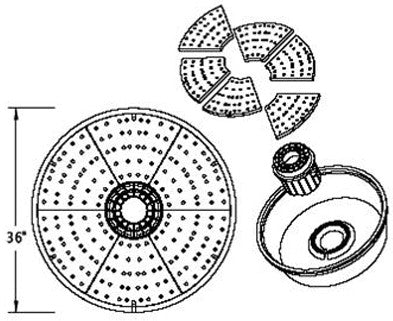
Click here to view the PDF version of the step-by-step instructions below.
You can view additional images here on our website showing this basin's components: use the arrows to flip through the full slideshow. This is a nice visual guide alongside these instructions.
For a visual guide, see the installation example below these instructions.
• Get your shovel and level out. Dig a hole 9″ deep, 30″ in diameter at the bottom, and sloping to 35″ in diameter at the top. Ensure that the ground at the bottom is level and solid (we used play sand from the hardware store in the bottom of the hole to create a nice “level” surface).
• Place the basin into the hole, with the power cord cut-out facing toward the power source. Level, moving earth or sand around if necessary.
• Set the round support “trunk” into the circular receptacle in the center of the basin and align the tubing cut-outs.
• Place the pump into the basin, running the power cord through the cord cut-out.
• Cut a length of tubing long enough to reach from the bottom of the basin to the top of the water feature. Run the tubing through the center hole in the top of the support and out the tubing cut-outs, then connect it to the pump outlet fitting.
• Install the 6 top plates.
• Place your Stone Forest water feature on top of the basin in the center, on the section of the support “trunk” that’s slightly higher than the plates.
• Pull the hosing up through the center cord-drilled hole in the fountain stone. You’ll notice that there is space left around the 1.25″ drilled hole and the either 1/2″ or 5/8″ diameter flexible garden hose that connects to your pump below. To fill the space around the hose and fit it snugly into the top of the core-drilled hole, we wrap the top part of the hose with a strip of pond liner and electrical tape. See images below for reference:

• Cover the reservoir with smooth river pebbles (or whatever you choose to use to conceal the basin). For this kit, we usually recommend Qty (6) 75-lb bags of the dark river pebbles.
• Fill your reservoir with water, plug the pump in, and VOILA! Grab a lounge chair and prepare to be relaxed by the soothing sounds of your new fountain.
INSTALLATION EXAMPLE:
View PDF, 36" Round Kit Basin with Rough Vessel step-by-step
You can view additional images by clicking on the link above, showing an example of the Stone Forest Rough Basin being installed at a private residence in New Mexico using the 36" Round Kit, pump, and pebbles. This is a nice visual guide alongside these instructions.
Here's a video showing the fountain installed and running:
2. Fountain Installation Kit, 44" Square Basin,

Click here to view the PDF version of the step-by-step instructions below.
You can view additional images here on our website showing this basin's components and installation: use the arrows to flip through the full slideshow. This is a nice visual guide alongside these instructions.
• Get your shovel and level out. Dig a hole 10″ deep, 29″ square at the bottom, and sloping to 37″ square at the top. Ensure that the ground at the bottom is level and solid (we used play sand from the hardware store in the bottom of the hole to create a nice “level” surface).
• Place the basin into the hole, with the power cord cut-out facing toward the power source. Level, moving earth or sand around if necessary.
• Insert the 8 supports into the 8 support holes.
• Place the center plate (gray) onto the supports, pressing firmly to ensure full installation.
• Cut a length of tubing long enough to reach from the bottom of the basin to the top of the water feature. Run the tubing through the center hole in the top of the center plate and connect it to the pump outlet fitting.
• Install the 4 top plates. On the side nearest the power supply, run the pump power cord out the cord gap, under the edge of the top plate, and through the cord cut-out.
• Install the 4 access covers, ensuring that the cut-out in each faces outward.
• Place your Stone Forest water feature on top of the basin in the center, where the 4 top plates meet.
• Pull the hosing up through the center cord-drilled hole in the fountain stone. You’ll notice that there is space left around the 1.25″ drilled hole and the either 1/2″ or 5/8″ diameter flexible garden hose that connects to your pump below. To fill the space around the hose and fit it snugly into the top of the core-drilled hole, we wrap the top part of the hose with a strip of pond liner and electrical tape. See images below for reference:

• Cover the reservoir with smooth river pebbles (or whatever you choose to use to conceal the basin). For this kit, we usually recommend Qty (6) 75-lb bags of the dark river pebbles.
• Fill your reservoir with water, plug the pump in, and VOILA! Grab a lounge chair and prepare to be relaxed by the soothing sounds of your new fountain.
___________________________________
We offer 3 installation kit designs that are made by combining components of wood, concrete, pond liner, and galvanized grating together to make your reservoir basin.
3. Fountain Installation Kit, 4×4′ - We no longer manufacture this kit, but it is an example of one you can make.
48" square x 12"H, holds approx 100 gallons of water

Click here to view the PDF version of the step-by-step instructions below.
You can view additional images here on our website showing this basin's
• Get your shovel and level out. Dig a hole 12″ deep, 48″ square. Ensure that the ground at the bottom is level and solid (you can use play sand from the hardware store in the bottom of the hole to create a nice “level” surface).
• Place the 4 pieces of 2x6 lumber provided into the sides of the hole, standing up like walls, leaving 1" standing above grade. Level, moving earth or sand around if necessary.
• Center the concrete pedestal and level. If there is a piece of wood running through the center of the pedestal, pop this out. Having the empty groove running down the middle is necessary for the hosing connection. If there is wood framing the sides, it's ok to leave this on.
• Unfold the pond liner, and spread it into the hole, running over top of the concrete pedestal, and down into the space around it. Helpful hint: place some kind of padding between the concrete pedestal and pond liner to prevent tearing/leaking. You could use excess pond liner, felt, or even newspaper to create a nice barrier. The weight of the water will want to pull the pond liner down on those corners, so this should help prevent future issues.
• Filling the reservoir with water at this step can help pull the pond liner down into place, so that you can staple the outer edges to the exterior 1" of wood frame all the way around, and then snip excess liner off neatly. If you don't want to add water yet, push the liner down into the hole as best you can before cutting excess so you don't run short.
• Place the galvanized grating over the hole. The edges should line up with the framing, and the cutout in the middle should line up with the groove in the top of the pedestal. This will accommodate your hosing, so it's important that the pond liner is pushed into the groove as much as possible.
• Place your Stone Forest water feature on top of the pedestal in the center.
• Cut a length of tubing long enough to reach from the bottom of the basin to the top of the water feature. Run the tubing through the center hole in the fountain, snaking out the bottom through the concrete pedestal's center groove, and out the side. Connect it to the pump outlet fitting. The pump should sit below the corner cut-out for easy access at anytime. There should be an extra square of galvanized grating that will act as the cover for this pump access (and prevent the pebbles from falling through).
• You’ll notice that there is space left around the 1.25″ drilled hole and the either 1/2″ or 5/8″ diameter flexible garden hose that connects to your pump below. To fill the space around the hose and fit it snugly into the top of the core-drilled hole, we wrap the top part of the hose with a strip of pond liner and electrical tape. See images below for reference:

• It's best if this pump access corner is on the side nearest the power supply. Run the pump power cord out the side, under the edge of the grating. Hide or bury as necessary (or as advised by your electrician).
• Cover the pump access area with the extra square of grating. Cover the reservoir with smooth river pebbles (or whatever you choose to use to conceal the basin). For this kit, we usually recommend Qty (6) 75-lb bags of the dark river pebbles.
• Fill your reservoir with water, plug the pump in, and VOILA! Grab a lounge chair and prepare to be relaxed by the soothing sounds of your new fountain.
4. Fountain Installation Kit, 6x6′ - We no longer manufacture this kit, but it is an example of one you can make.
72" square x 12"H, holds approx 250 gallons of water

Click here to view the PDF version of the step-by-step instructions below.
• Get your shovel and level out. Dig a hole 12” deep, 72” square. Ensure that the ground at the bottom is level and solid (you can use play sand from the hardware store in the bottom of the hole to create a nice “level” surface).
• Place the 4 pieces of 2x6 lumber provided into the sides of the hole, standing up like walls, leaving 1” standing above grade. Level, moving earth or sand around if necessary.
• Center the concrete pedestal and level. If there is a piece of wood running through the center of the pedestal, pop this out. Having the empty groove running down the middle is necessary for the hosing connection. If there is wood framing the sides, it’s ok to leave this on.
• Unfold the pond liner, and spread it into the hole, running over top of the concrete pedestal, and down into the space around it. Helpful hint: place some kind of padding between the concrete pedestal and pond liner to prevent tearing/leaking. You could use excess pond liner, felt, or even newspaper to create a nice barrier. The weight of the water will want to pull the pond liner down on those corners, so this should help prevent future issues.
• Filling the reservoir with water at this step can help pull the pond liner down into place, so that you can staple the outer edges to the exterior 1” of wood frame all the way around, and then snip excess liner off neatly. If you don’t want to add water yet, push the liner down into the hole as best you can before cutting excess so you don’t run short.
• Place the galvanized grating over the hole. Note: there will be Qty (2) 4’ x 6’ sheets that will overlap to create the 6x6’ square. The edges should line up with the framing, and the cutout in the middle should line up with the groove in the top of the pedestal. This will accommodate your hosing, so it’s important that the pond liner is pushed into the groove as much as possible.
• Place your Stone Forest water feature on top of the pedestal in the center.
• Cut a length of tubing long enough to reach from the bottom of the basin to the top of the water feature. Run the tubing through the center hole in the fountain, snaking out the bottom through the concrete pedestal’s center groove, and out the side. Connect it to the pump outlet fitting. The pump should sit below the corner cut-out for easy access at anytime. There should be an extra square of galvanized grating that will act as the cover for this pump access (and prevent the pebbles from falling through).
• You’ll notice that there is space left around the 1.25” drilled hole and the either 1/2” or 5/8” diameter flexible garden hose that connects to your pump below. To fill the space around the hose and fit it snugly into the top of the core-drilled hole, we wrap the top part of the hose with a strip of pond liner and electrical tape. See images below for reference:

•It’s best if this pump access corner is on the side nearest the power supply. Run the pump power cord out the side, under the edge of the grating. Hide or bury as necessary (or as advised by your electrician).
• Cover the pump access area with the extra square of grating. Cover the reservoir with smooth river pebbles (or whatever you choose to use to conceal the basin). For this kit, we usually recommend Qty (11) 75-lb bags of the dark river pebbles.
• Fill your reservoir with water, plug the pump in, and VOILA! Grab a lounge chair and prepare to be relaxed by the soothing sounds of your new fountain.
5. Installation Kit for the 39" Triple Basalt Fountain - We no longer manufacture this kit, but it is an example of one you can make.
72" square x 12"H, holds approx 220 gallons of water
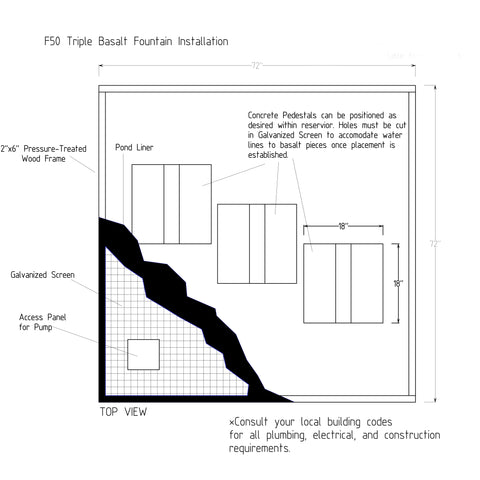
Click here to view the PDF version of the step-by-step instructions below.
• Get your shovel and level out. Dig a hole 12” deep, 72” square. Ensure that the ground at the bottom is level and solid (you can use play sand from the hardware store in the bottom of the hole to create a nice “level” surface).
• Place the 4 pieces of 2x6’ lumber provided into the sides of the hole, standing up like walls, leaving 1” standing above grade. Level, moving earth or sand around if necessary.
• Unfold the pond liner, and spread it down into the hole and up over the sides.
• Center the concrete pedestals in a row (or arrange as you wish). If there is a piece of wood running through the center of the pedestals, pop these out. Having the empty groove running down the middle is necessary for the hosing connections. If there is wood framing the sides, it’s ok to leave this on.
Helpful hint: place some kind of padding between the concrete pedestals and pond liner to prevent tearing/leaking. You could use excess pond liner underneath the edges/corners for additional protection. Keep in mind that the concrete will be exposed to the water, so you may consider waterproofing your concrete pedestals ahead of time with a waterproofing agent. We like CIM’s products: http://cimindustries.com/wp-content/uploads/2013/05/Waterproofing-Guide-Fountains.pdf
• Staple the outer edges to the exterior 1” of wood frame all the way around, and then snip excess liner off neatly. If you don’t want to add water yet, push the liner down into the hole as best you can before cutting excess so you don’t run short.
• Place the galvanized grating over the hole. Note: there will be Qty (2) 4’ x 6’ sheets that will overlap to create the 6x6’ square. The edges should line up with the framing, and you’ll need to mark and make cuts over the centers of each pedestal. You can use a power tool like an angle grinder to make the cuts, but please be careful! Safety gear should be worn, and having a friend present to stabilize (and supervise?) is probably wise!
Once the cuts are made and you have aligned the grating over each pedestal, make sure that the pond liner is pushed down into each concrete pedestal groove: this will accommodate your hosing. You’ll also want to cut a pump access hole in one of the corners closest to your power supply. This hole should be slightly smaller than the ones you just cut for the hose access, since one of these extra pieces will become the “trap door” cover for the pump access hole.
• Place and center your Stone Forest Triple Basalt water feature on top of each pedestal.
• Cut a length of tubing long enough to reach from the bottom of the basin to the top of the water feature: do this three times, since there is 1 pump for each section. Run the tubing through the center holes in the fountain, snaking out the bottom through the concrete pedestal’s center groove, and out the side. Connect it to each pump’s outlet fitting. The pumps should sit below the corner cut-out for easy access at anytime. There should be an extra square of galvanized grating that will act as the cover for this pump access (and prevent the pebbles from falling through).
• You’ll notice that there is space left around the 1.25” drilled hole and the 5/8” diameter flexible garden hose that connects to your pumps below. To fill the space around the hose and fit it snugly into the top of the core-drilled hole, we wrap the top part of the hose with a strip of pond liner and electrical tape. See images below for reference:

• It’s best if this pump access corner is on the side nearest the power supply. Run the pump power cord out the side, under the edge of the grating. Hide or bury as necessary (or as advised by your electrician).
• Cover the pump access area with an extra square of grating (from the cuts you made previously). Cover the reservoir with smooth river pebbles (or whatever you choose to use to conceal the basin). For this kit, we usually recommend Qty (11) 75-lb bags of the dark river pebbles.
• Fill your reservoir with water, plug the 3 pumps in, and VOILA! Grab a lounge chair and prepare to be relaxed by the soothing sounds of your new fountain.
(An important note: If you are concerned about securing each section of this fountain into place to prevent them from falling over, Stone Forest can drill additional holes for "pinning" it into place. You'll need to drill holes into the concrete pedestals that align with these pin holes on site, and set stainless steel pins so that the basalt sections can slide into place. You could also pour the concrete pedestals on site and place the pins beforehand. Some installations may be in commercial environments, have earthquake risks, or have exposure to small children, pets or weather that could cause concern should the fountain move. No one wants their fountain to turn into dominoes! Please give Stone Forest a call to discuss additional pin-hole drilling costs and details.)
___________________________________
In the Japanese tradition, water features run with a trickling bamboo spout instead of bubbling up through a center hole in the basin. Let's take a look at how that setup works a little differently.
6. Basin with bamboo spout installation
Click here to view the PDF version of the step-by-step instructions below.
For a visual guide, see installation example below these instructions.
• Get your shovel and level out. Dig a hole 10” deep, 29” square at the bottom, and sloping to 37” square at the top. Ensure that the ground at the bottom is level and solid (we used play sand from the hardware store in the bottom of the hole to create a nice “level” surface).
• Place the basin into the hole, with the power cord cut-out facing toward the power source. Level, moving earth or sand around if necessary.
• Insert the 8 supports into the 8 support holes.
• Place the center plate (gray) onto the supports, pressing firmly to ensure full installation.
• Install the 4 top plates. On the side nearest the power supply, run the pump power cord out the cord gap, under the edge of the top plate, and through the cord cut-out.
• Install the 4 access covers, ensuring that the cut-out in each faces outward.
• Place your Stone Forest water feature on top of the basin in the center, where the 4 top plates meet.
• Place the bamboo spout beside the fountain so that the spout is positioned over the center of the basin. You can prop the spout up by surrounding it with pebbles (see step #9), or if you’d like to secure it to the kit (to keep it from tipping over on a windy day) we suggest connecting a wooden dowel up and into the side of the hollow base using a screw. You can then feed the dowel down through one of the holes in the top of the panels below (start by measuring the diameter of the holes and find a dowel slightly smaller in diameter). Alternatively, feel free to create your own method for securing the spout using tools at hand.
• Cover the reservoir with smooth river pebbles (or whatever you choose to use to conceal the basin). For this kit, we usually recommend Qty (6) 75-lb bags of the dark river pebbles. You can build up the pile of pebbles around your spout to stand it in place, if you decide not to secure it to the kit panels below.
• Fill your reservoir with water, plug the pump in, and VOILA! Grab a lounge chair and prepare to be relaxed by the soothing sounds of your new fountain. Adjust the position of the bamboo spout as necessary so that the stream of water hits near the center of the basin (or wherever you prefer the sound and look best).
INSTALLATION EXAMPLE:
View PDF, 36" Round Kit Basin with Bamboo Spout and Ishi Basin step-by-step
You can view additional images by clicking on the link above, showing an example of the Stone Forest Ishi Basin being installed at a private residence in Virginia using the 36" Round Kit, bamboo spout, pump, and pebbles. This is a nice visual guide alongside these instructions (remember: you can use either the 36" or 44" kit depending on what's best for your setup).
Here's a video showing the fountain installed and running:
___________________________________
A note regarding shipping & packing:
We pack our items with pride and care. If anything arrives damaged, please call us right away and take photos for reference. Our 36" Round and 44" Square plastic reservoir kits are typically placed on top of your crated/palletized shipment (the fountain, pump and pebbles will be underneath), and our heavier 4x4', 6x6' and 39" Triple Kits are often palletized separately. Here's a few snapshots from the Stone Forest workshop showing an example of a 6x6' Installation Kit ready for freight pickup.

You'll notice that the heavy concrete pedestal is at the bottom, still in its framing from when it was poured (you can pop the wood 2x4' out of the top center, which creates a groove to accommodate your hosing), the galvanized grating stands in vertical sheets, and the wood 2x6's are meant for your reservoir hole's framing in the ground.
Please remember not to discard anything that arrives with your shipment until all components are accounted for, or fully installed. If you have questions about what you received, just give us a ring.
___________________________________
7. Custom Installations
Sure, the methods above are certainly not the only way to install a water feature! You can get quite creative with how your Stone Forest water feature is displayed. Below are just a few of our favorite examples showing how our clients decided to work with their architect or designer to create alternative reservoir setups:

Here's our Small Antique Millstone Fountain with a custom-order base pedestal for added height in a front entry courtyard with custom pool and submerged river pebbles.

Here's our Curved Waterwall in blue-gray granite in a custom above-ground reservoir with contemporary border and giant pavers. This home and landscape was featured in Garden Design Magazine. (Image courtesy of Jack Coyier Photography of Santa Monica, CA).

Check out this stunning Custom Helix Fountain in a series of cascading pools. Love how you can see right into the water.
If you decide to take the more creative route, please consult with a professional so that your Stone Forest fountain is properly supported and still allows for easy maintenance and access.
If you decide to install your water feature using one of our methods listed above, keep in mind that you can add some beautiful finishing touches that really complete the look, for example, build in a border of larger rocks around the river pebbles like we did for our Marubachi Fountain:

...or soften the edges with surrounding plant life, and really integrate it into your garden and landscape, like this Rough Vessel with bamboo spout, as featured in Fine Gardening Magazine:

If you've made it this far: we hope this article makes you feel like you're a true Stone Forest water feature aficionado! and bravo for sticking with it to the end. Now go brag to all your friends about your new fountain...and exactly how it works. Or, if you're reading this for information prior to your purchase: just buy it! You'll love your Stone Forest fountain each and every day.


[in Just-]
by E. E. Cummings
in Just-
spring when the world is mud-
luscious the little
lame balloonman
whistles far and wee
and eddieandbill come
running from marbles and
piracies and it's
spring
when the world is puddle-wonderful
the queer
old balloonman whistles
far and wee
and bettyandisbel come dancing
from hop-scotch and jump-rope and
it's
spring
and
the
goat-footed
balloonMan whistles
far
and
wee


Let’s get to know Cameron Johnson. Oh hey, that’s me! My extension here at Stone Forest is 1007, which I have loved since day one since it means I’m “double oh seven” at your service. Working with the dynamite archive of photography, spending quality one-on-one time with visiting clients, watching our newly introduced designs blossom in the marketplace, and working side-by-side with my dynamic coworkers are just a “few of my favorite things” from my day-to-day with this company.
What’s your position at Stone Forest, and when did you start working here? Marketing and Garden Collection Sales Manager. August 2007
Which Stone Forest Kitchen & Bath product gets you really jazzed up, and why? I remember walking into the Stone Forest gallery for the first time, and stopping in my tracks as I noticed the Veneto Pedestal Sink standing proud against the wall. The shape and sheer mass of the design is stunning (not to mention the onyx ones glow when backlit), and is at once contemporary/timeless.

And your favorite Garden product? Oh, those Basalt Dome fountains!

Hometown: Charlottesville, VA
Alma mater: University of Virginia. Wahoowa!
Childhood hero: Madonna. (you know, the 80s “I wanna rule the world”, cone-wearing badass version).
Favorite activities: Making things, being a total Francophile, collecting items washed ashore, taking on the annual challenge of having a Southwestern garden in zone 6b, swimming laps, hiking and snowshoeing in the NM wilderness, and above all, traveling this wide world.
Song that gets me dancing: “Let’s Dance”, David Bowie
Signature cocktail: Manhattan made with Bulleit bourbon, straight up, in a coupe glass with a luxardo maraschino cherry. “Shaken, not stirred” as Bond would say.
Last meal on earth: My husband Andy’s spaghetti.
Book/movie you’ve read/seen over and over: Dirty Dancing. I broke the VHS tape I watched it so much. My parents were a bit concerned.
If you could have dinner with one person from history, it would be: Edith Piaf
Favorite place you’ve traveled or vacationed: Paris, France. And a very close second: The Saguaro National Forest in Tucson, AZ. Those cacti are otherworldly.
If you could travel anywhere in the world, you would choose to explore: Australia & New Zealand.
Why Santa Fe? Because you could probably walk about town in a Halloween costume on any given day and blend in. The culture is rich, the art is heavy, and the people are crazy (in a good way).
Why is working at Stone Forest so awesome? The team and the product are solid as a rock. We work hard and play hard.
I’m known for: My karaoke addiction.
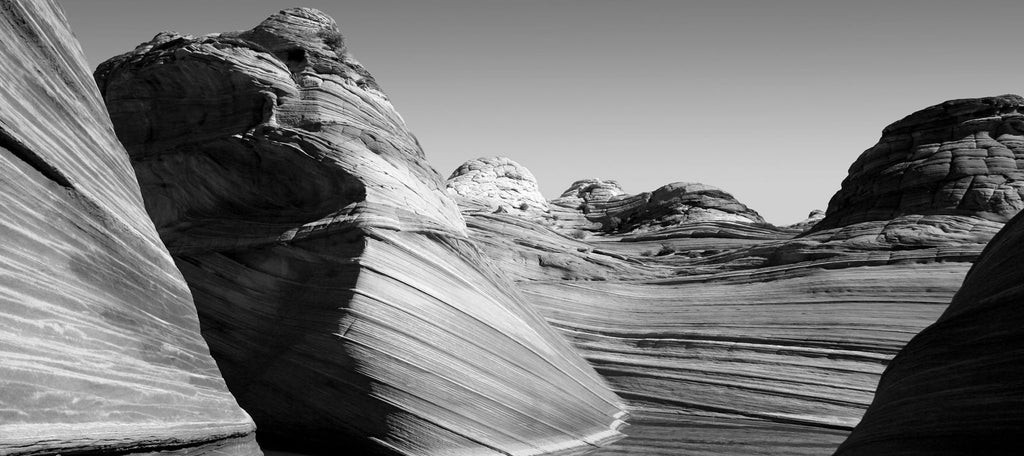

As we welcome twenty sixteen, we reflect on our fast-paced environment and encourage you to unplug, slow down, and get outside this weekend. Celebrate that which inspires us most: the vast space and beauty of nature. Give yourself some quiet time to heighten your senses and prepare for what’s to come. Your gadget(s) will be there waiting for you afterwards, we promise.
A hand-written, stamped, and sealed envelope received here at Stone Forest reminded us of our need to send something other than a text or email! There’s no substitute for something hand-crafted.

And now, a few little haiku gems to read, digest, and help you slow the pace:
No sky
no earth – but still
snowflakes fall.
~Hasin
The lamp once out
Cool stars enter
The window frame.
~Natsume Soseki
Experimenting…
I hung the moon on various
branches of the pine
~Hokushi
Happy New Year from the nature-loving, hand-crafting, design-inspired team at Stone Forest


BEFORE + AFTER : in his element
Let’s get to know Michael Zimber: Company founder, outdoor enthusiast, globetrotter, nature-addict, and the captain of the Stone Forest ship–always navigating forward as the waves of the world ebb and flow. And as the story goes: he gave up his time on the water as a river guide soon after his mom asked, “when are you gonna get a real job?” He recalls that her timing couldn’t have been better, and thought, “if I could somehow bring what I loved about being in the wilderness into people’s homes and gardens, it might turn into a rewarding new direction. Today, over 25 years later, I have stayed true to this original concept.” Indeed. Stone Forest designs celebrate the simple beauty of natural materials.
He’s also known as “MZ”, although there’s no zzzzzz’s about this guy. He’s always a step ahead and his goal is to release six new designs every year. Surf’s up!
What’s your position at Stone Forest, and when did you start working here? OMG, since 1989.
Which Stone Forest Kitchen & Bath product gets you really jazzed up, and why? SYNC is still one of the coolest designs we’ve come up with. It’s hand-carved, modular, and works in a variety of applications.

And your favorite Garden product? Mizubachi fountains still do it for me. We created the design in 1991, and continue to make it today.

Hometown: Manhasset, NY
Alma mater: Prescott College in Arizona
Childhood hero: Tarzan
Favorite activities: Kayaking, backcountry skiing, and climbing.
Song that gets me dancing: “Roam” by the B-52’s
Signature cocktail: A cold IPA
Last meal on earth: A plate of Pad Thai at a street stall in Bangkok.
If you could have dinner with one person from history, it would be: Sir Richard Francis Burton: explorer, linguist and orientalist.
Favorite place you’ve traveled or vacationed: Burma
If you could travel anywhere in the world, you would choose to explore: Chile is perhaps next on my list.
Why Santa Fe? It attracts other weirdos like me + arts and culture + access to the outdoors.
Why is working at Stone Forest so awesome? Being around stone, water and cool, creative people.
Posted on February 01 2015
Read Full Article

Bell tower in the entrance area of the Japanese Garden at the Albuquerque Bio Park in New Mexico.
When Catherine Hubbard came to Stone Forest to purchase a traditional Japanese Oribe lantern this past summer, we chatted about how inspiring just one sculptural element can be in an outdoor space. Then, in December, she reached out and invited me and Michael Cahill to visit the Sasebo Japanese Garden at the Albuquerque Bio Park, where she happens to be the Botanic Garden Manager. MC and his family are already members there, and enjoy the year-round activities that the gardens, zoo, and aquarium have to offer. We chatted on the drive down about the upcoming night-time show that they have each year for the holidays, called “River of Lights.”
Catherine explained her invitation:
“Toru Tanaka is the designer of the Japanese Garden in the park, completed in 2007, and continues to make frequent visits here to keep us true to his vision, and assist us with pruning. In mid-December, Toru will be here with two of the members of his crew from his company in Portland, Japanese Garden Specialty. They are always fascinating to watch as they prune our Japanese Black Pines and other plants as needed.
Toru is an amazing person, and we feel so fortunate to have him as our designer and consultant: he is a true creative artist, as well as a talented and skilled horticulturist, and a nice person. Here is a 2007 biography of Mr. Tanaka, who has been the Director of the Portland JG, has worked on the Anderson JG, and currently consults regularly with the Japanese Ambassador in D.C. on his garden (which is also in the Ogata style).
If you, and/or any of your staff, would like to come to our BG while Toru is here, we would love to host you and introduce you to him. We are just so proud of his work, and love to share him with others in NM who can also appreciate his skills and Japanese philosophy.”

The wood entry gate to the rest of the garden, with carefully placed long, rectangular stone pavers along the pathway.
Needless to say, it was an honor to walk and discuss the four-acre garden with Toru–a humble, generous person and a gentle soul. As we entered through large wooden gates, the pathway opens up to a large waterfall, central koi pond, and mixture of plant-life. Catherine pointed out that Toru didn’t want to tear down the existing native flora, but blend it with his traditional vision, creating a truly unique Japanese garden that also embraces Albuquerque’s natural beauty. One of the most dramatic elements that remains is the large cottonwood trees that stand as a towering backdrop to lanterns, pruned pines, curved bridges, and other hand-selected elements.

The reflective koi pond encourages meditation and inner-quiet.
As we walked the garden paths, we observed many large boulders bordering the garden paths and the pond edges, and Toru explained that he was very specific about the placement of these heavy stones, which speak directly to the wabi-sabi aesthetic, embracing the asymmetry and imperfections found in the natural world. Although the arrangement was very deliberate, the subtle hand of the designer attempts to mimic nature, and make it look as if the boulders have been there for centuries; this is a sign of success, explained Toru.

Observing the Ogata Kai Garden.
Left to right: Maria Thomas (asst. curator for the Japanese Garden), Michael Cahill (general manager + co-owner at Stone Forest), Toru Tanaka (Landscape Architect), and Catherine Hubbard (ABQ Botanic Garden manager).
We stopped quietly at the landscape’s newest addition: “a ‘garden-within-a-garden’ designed by five members of the Ogata Kai organization of Japanese landscape architects. The five architects, trained under the late Kenzo Ogata, created this beautiful garden in just four days (September 14-17, 2009),” explained Catherine.

A Yukimi Lantern stands in a quiet stream.

Catherine, MC, and Toru enter the bamboo forest.
After following the pathways around the koi pond’s curve, meandering along the streams, and stopping to listen to the waterfall, the loop finishes with a small, lush bamboo forest tunnel. After thanking Toru for this time, I asked him if he felt proud of his accomplishment. He smiled, shyly, and said, “Oh, yes yes, sure. But it is always changing–never finished.” He then returned to his crew member’s side, who stood atop a ladder asking for confirmation on the spot where he was pruning a pine tree. They will take years to coax and shape into what Toru is envisioning.

A pagoda-style sculpture sits on a hilltop.
I would encourage locals and visitors alike to visit this beautiful garden. And a big thanks to Catherine for sharing this little sanctuary in the city.
For more information, visit:
http://www.cabq.gov/culturalservices/biopark/
https://www.facebook.com/abqbiopark
Here are some more tagged snapshots on flickr from various visitors.
All photos above taken by Cameron Johnson.


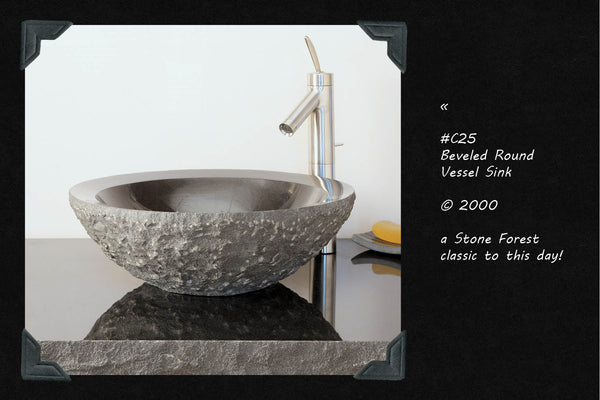













Posted on December 30 2013
Read Full Article


















Let’s get to know Michael Cahill: Renaissance man, co-pilot, stone aficionado, patience guru, CADD master, the glue that keeps this team together, and the guy that always has all the answers. Also known as “MC”: short for Michael Cahill or master of ceremonies.
What’s your position at Stone Forest, and when did you start working here? General Manager and partner, 1997.
Which Stone Forest Kitchen & Bath product gets you really jazzed up, and why? The Papillon bath tub. It was the first ‘unusual’ shape that we introduced into our line and was a lot of fun creating in CADD.

And your favorite Garden product? Mizubachi Fountain. I love the black granite and it’s mass and really enjoy the contrasting textures on this piece particularly.

Hometown: North Tonawanda, NY
Alma mater: State University of New York College of Environmental Science and Forestry (or SUNY ESF for short)
Childhood hero: Tony Hawk
Favorite activities: Mountain Biking, Hiking, Snowboarding, spending time with the family.
Last meal on earth: Anything with green chile!
Book/movie you’ve read/seen over and over: Brotherhood of the Wolf.
Favorite place you’ve traveled or vacationed: Ireland
Why Santa Fe? I fell in love with the people, the environment and the sun when I came out visiting at the age of 16.
Why is working at Stone Forest so awesome? The varied tasks and opportunities that make almost every day different.
I’m known for: My laid back kinda style.
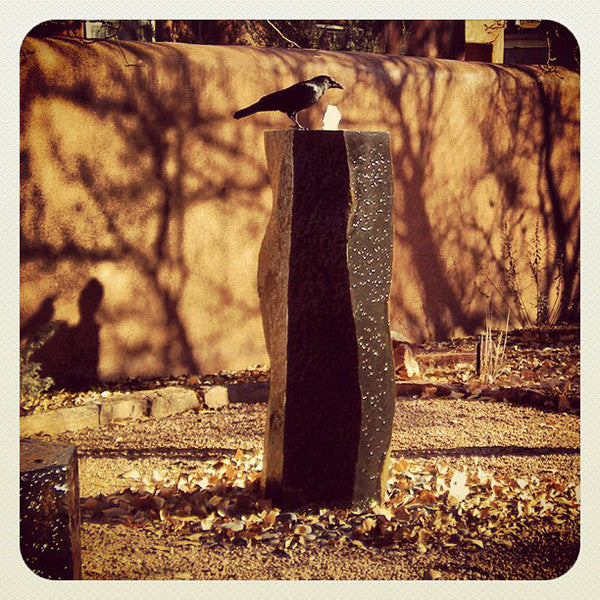


Posted on October 26 2012
Read Full Article
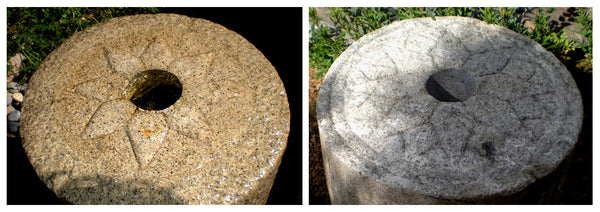
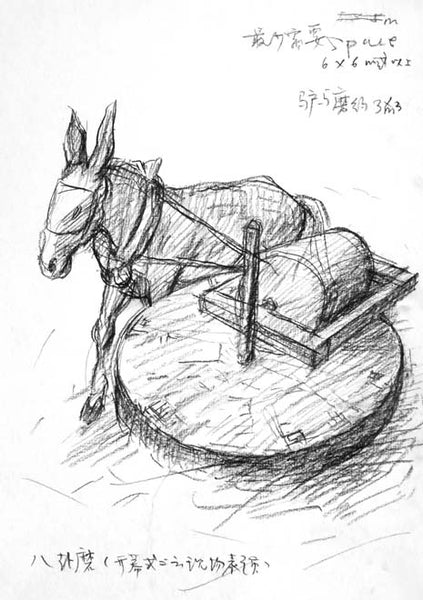

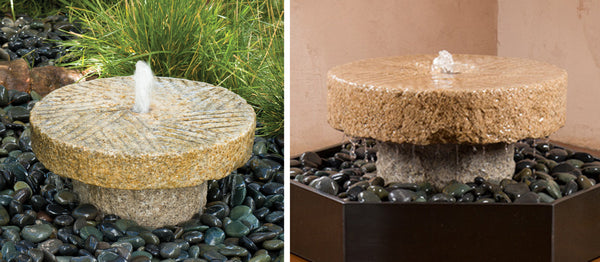


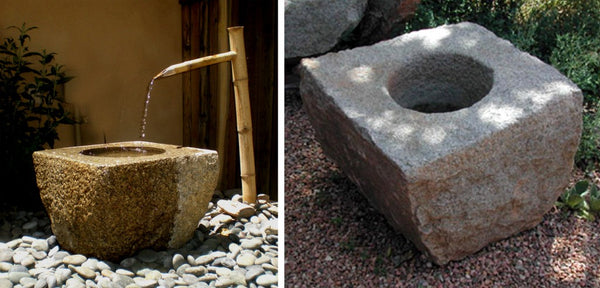

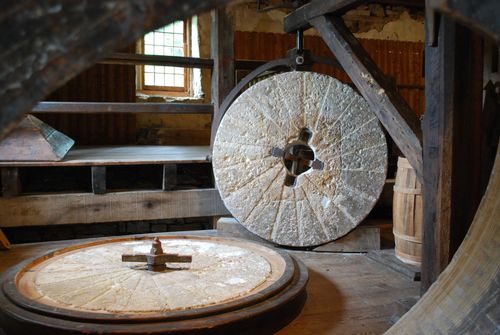
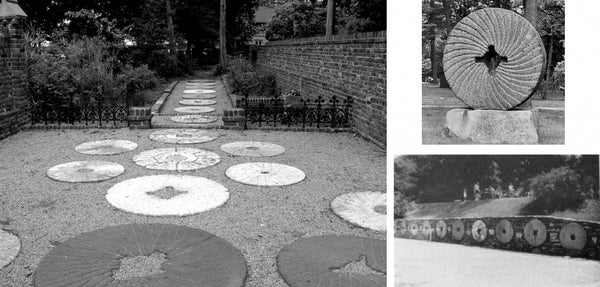



Japanese Shide |
Photo taken by John Kinkade of Columbine Gallery in Loveland, CO
This traditional Shide (pronounced she-day) is a folded zig-zag shaped white paper sculpture that hangs in the entryways of Japanese temples and shrines. Hung for the New Year, they usually adorn these twisted rice ropes, or Shimenawa, which are said to separate the sacred from the profane, keep impurities out, and purify the space within.
Shide paper strips are also attached to a wooden “wand” and then used in a Shinto ritual called harai, or “sweeping” to remove unwanted spirits or impurities. I love how Timothy Takemoto (sourced below) theorizes that the shape “resembles lightning” and the sound is a rustling that “hangs in the air” and wakes the spirits.
On a recent visit to Stone Forest, our friend John Kinkade brought some of these Shide for us to see in person. In honor of the new year, I leave you with this powerful, delicate, cleansing symbol.
Here’s to new beginnings.
Sources |
Wikipedia: The Free Encyclopedia. http://en.wikipedia.org/wiki/Shide_%28Shinto%29
To learn how to fold a Shide, and read more about their significance, visit this site created by Timothy Takemoto.



Piper Leigh is the founder of Comunica, where she designs “interactive workshops to help leaders and teams communicate, collaborate and innovate” by encouraging creative interactions. She publishes limited edition artist books, participates in collaborative projects, and creates installations with different forms and materials like scrolls, mobiles, and kimonos.






 1. Ornament and Tradition | Historical context for enduring design Traditional bronze Japanese temple lanterns in Kyoto, Japan | Photo by Carl Parkes of San Francisco, CA The temples and shrines of Japan used lanterns made in bronze, iron, and stone to hold votive candles as a decorative,...
1. Ornament and Tradition | Historical context for enduring design Traditional bronze Japanese temple lanterns in Kyoto, Japan | Photo by Carl Parkes of San Francisco, CA The temples and shrines of Japan used lanterns made in bronze, iron, and stone to hold votive candles as a decorative,...






 Although traditional Japanese stone lanterns were not designed with the intention of providing enough light for seeing at night, Western civilization has often adapted these designs to provide functional lighting. “In Japan putting an electric light bulb in your stone lantern might be seen as somewhat humorous,” writes Sukiya Living Magazine. Indeed, you’ll find that most U.S. Japanese Gardens or private enthusiasts are more likely to point a spotlight toward the stone lantern so that it can be admired, versus installing bulbs or candles inside. Here at Stone Forest, we core-drill most of our lantern designs to accommodate electrical wiring so that you can choose how you use them. You’ll find that our few exceptions to drilling are the more ornate pieces, like the Kotoji, which don’t take the drilling due to their shape, delicate size, or overall design. Since we are “core” drilling, the hole is hiding on the interior of the piece, so it’s not a hindrance to the overall appearance. Assembly is also important to stone lantern display. Sukiya Living Magazine explains the names and positioning of the different sections of a large stone pedestal-style lantern, all carved carefully for balance and easier moving. We’ll use our Kasuga lantern here as a visual reference:
Although traditional Japanese stone lanterns were not designed with the intention of providing enough light for seeing at night, Western civilization has often adapted these designs to provide functional lighting. “In Japan putting an electric light bulb in your stone lantern might be seen as somewhat humorous,” writes Sukiya Living Magazine. Indeed, you’ll find that most U.S. Japanese Gardens or private enthusiasts are more likely to point a spotlight toward the stone lantern so that it can be admired, versus installing bulbs or candles inside. Here at Stone Forest, we core-drill most of our lantern designs to accommodate electrical wiring so that you can choose how you use them. You’ll find that our few exceptions to drilling are the more ornate pieces, like the Kotoji, which don’t take the drilling due to their shape, delicate size, or overall design. Since we are “core” drilling, the hole is hiding on the interior of the piece, so it’s not a hindrance to the overall appearance. Assembly is also important to stone lantern display. Sukiya Living Magazine explains the names and positioning of the different sections of a large stone pedestal-style lantern, all carved carefully for balance and easier moving. We’ll use our Kasuga lantern here as a visual reference:


Picture a small, dirt yard brimming with traditional Japanese hand-carved granite lanterns in Santa Fe, New Mexico in the year 1989. Picture the owner of this small business, who has just returned from a life-changing trip to Japan, and who envisions a show-stopping, landscaped garden gallery full of running fountains, lanterns, water basins, benches and a koy pond, complete with blooming water lilies and a granite bridge.